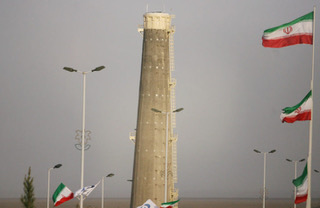Exclusive: How Israel is attacking Iran’s nuclear sites

Israel has carried out three major operations over the last eighteen months against Iran’s nuclear sites. These attacks involved as many as a thousand Mossad personnel and were executed with ruthless precision using high-tech weaponry including drones and a quadcopter — and spies within Tehran’s holy of holies, its nuclear program.
While Joe Biden’s nuclear negotiators try to snatch catastrophe from the jaws of defeat in Vienna, Israel is taking things more seriously.
Last week, Naftali Bennett, the Israeli prime minister, pivoted to a new policy on Tehran: retaliating against aggression from militias backed by Tehran with covert strikes on Iranian soil.
This builds on the extensive capabilities that the Mossad has built up in the Islamic Republic in recent years. In February — seven months before the New York Times “broke” the same story — I exposed in the Jewish Chronicle of London how Israeli spies killed nuclear scientist Mohsen Fakhrizadeh using a remote-controlled machine gun. I can now reveal the secrets behind Israel’s latest triple attack on Iran’s nuclear ambitions.
The tripartite sabotage effort began on July 2, 2020, with a mysterious explosion in the Iran Centre for Advanced Centrifuges (ICAC) facility at Natanz, one of the ultra-secure nuclear sites that are dotted around Iran.
At first, the Iranians were mystified. The building had apparently blown itself up. But how? The answer, as they say, shocked them. When the Ayatollah’s apparatchiks were renovating the facility in 2019, Israeli agents had posed as construction merchants and sold them building supplies. Those building supplies were packed with explosives. A year later, they were detonated by Tel Aviv.
Although this created substantial damage, the Natanz plant was far from out of the game. Beneath a protective layer of forty feet of concrete and iron lay the inner sanctum of the A1000 subterranean hall. Inside were up to 5,000 centrifuges that whirred away day and night, minute by minute taking the Iranian regime closer towards a nuclear weapon.
The second phase of the plan swung into action. Mossad spies approached up to ten Iranian scientists who had access to this holy of holies and managed to persuade them to switch sides — though they led the the scientists to believe that they were working for international dissidents, not Israel.
Incredibly, the scientists agreed to blow up the high security facility. “Their motivations were all different,” a well-placed Israeli source tells me. “Mossad found out what they deeply wanted in their lives and offered it to them. There was an inner circle of scientists who knew more about the operation, and an outer circle who helped out but had less information.”
There remained the puzzle of getting the explosives into the fortified complex. This was achieved in two ways. First, a drone flew into its airspace and delivered the bombs to an agreed location to be collected by the scientists. Then came the smuggling.
“Let’s say you wanted to get explosives into Natanz,” a source told me, coyly. “How could you do it? You could, for example, think about how people working there need to eat. They need food.
“So you could put the explosives in the lorry that delivers the food to the canteen, and the scientists could pick it up once it’s inside. Yes, you could do that.”
The plan worked. The scientists collected the bombs and installed them. In April, after Iran announced that it had started to use advanced IR-5 and IR-6 centrifuges in the underground hall — in brazen defiance of its nuclear commitments — the explosives were triggered.
The blast destroyed the secure power system, causing a blackout. Ninety percent of the centrifuges were destroyed, putting the facility out of action for up to nine months. The scientists instantly vanished. All are alive and well today.
Mossad’s attention then turned to the production of the centrifuges themselves, to disrupt the regime’s attempt to restore the Natanz facility. The crosshairs moved to Karaj, thirty miles northwest of Tehran, where the Iran Centrifuge Technology Company (TESA) is located.
Over the preceding months, a team of Israeli spies and their Iranian agents had jointly smuggled an armed quadcopter — weighing the same as a motorcycle, a source confirmed — into the country, piece by piece. Now it was time to deploy it.
On June 23, the team assembled the kit and took it to a location ten miles from the TESA factory. The operatives launched it, piloted it to the factory and released the payload, causing a large explosion. Then the drone returned to the launch site where it was spirited away to be used again.
It is significant that these operations took place while the negotiations were continuing in Vienna. The Mossad operations were carried out without international collaboration. To use Israeli intelligence slang, the attacks were “blue-and-white” rather than “blue-white-and-red”, which refers to American involvement. This is significant, too.
In recent weeks, Axios reported, Israel has shared intelligence proving that Iran has been laying the technical groundwork for enriching uranium to 90 percent purity, the level required for a bomb.
While Biden’s team, saturated with naïveté and a Back to the Future focus on the Obama years, fruitlessly pursues jaw-jaw in Vienna, the cynical Iranians are preparing for war — and the Mossad, whose instincts are sharpened by the desire to protect their families from annihilation, is trying to stop them.
The contrast between cloud-cuckoo Washington and post-Holocaust Jerusalem is stark. And in seven months’ time, you might read even this in the New York Times.
Jake Wallis Simons is deputy editor of the Jewish Chronicle.